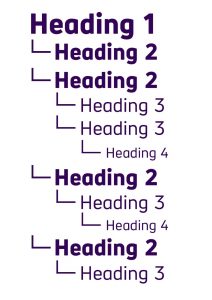People who might have trouble reading print often use text-to-speech programs or screen readers.
A text-to-speech program is any program, app, or extension that reads text aloud. These programs only read text and will not read out buttons, navigation instructions, or alt text for pictures. Many people use text-to-speech programs including people with low vision, dyslexia, learning differences, and concussions/TBI. Additionally, there are many people without particular accessibility needs who enjoy using text-to-speech to be more productive and streamline their workflow. On the other hand, screen readers are programs that read out every element on screen and give navigation instructions, with the assumption that the user cannot see anything on the screen. Screen readers are primarily used by people who are blind.
When creating your files, it is important to create them in such a way that people who have varying levels of visual acuity and people who listen to text are able to access all the written information.
Color contrast, font, size, and plain language
When creating a document, it is important to be mindful of how your text appears. The color, font, and size all make a difference in whether someone can read the text or not. Here are some tips to make sure your text is readable.
Color Contrast
It’s important that there is sufficient color contrast between the color of the text and the background so that people with low vision conditions can read it easily. Generally, black text on a white background is a good option, because it is readable by a large population. If you are planning on using different colors, please use a color contrast analyzing tool to make sure that there is sufficient contrast.
Font and Size
It is best to use a san serif font when writing, as these fonts are most accessible. Please avoid any overly ornate fonts that can make it hard to distinguish letters. Additionally, underlining text or using italics can make it difficult for some people to distinguish letters. If you must emphasize a portion of text, using bold letters is the best choice.
It is recommended that font size be above 11 point font to ensure accessibility.
Signifying Important Information
Sometimes people make text bold or a different color to signify important information. However, this is not a good system to use since people who access documents by listening to a screen reader or text-to-speech program will not be able to hear “bold” or “color.”
For this reason, if you need to signify important text, it is important to do so in more than one way. For example, if you write the word “important” and then write the information that is important, a person will be able to hear that read aloud. Likewise, if you write a note that important text will be signified by an asterisk and then use an asterisk to note important text, a person listening will be able to hear the asterisk read aloud. In conclusion, it is okay to use bold font or colored font to signify importance, but if you do so, you must also have an additional way of noting its importance that a text-to-speech program or screen reader will be able to speak aloud.
Plain Language
Its important to write content that everyone can understand. Highly intelligent people can struggle with reading comprehension for a variety of reasons, ranging from having a learning difference to reading a text in their non-native language. Following plain language guidelines in your writing will ensure that text is as accessible as possible.
For this week’s clue, complete the activity listed under Week 3 in the Keep Calm and Check Accessibility Moodle Page.
